Genre: Simulation Developer: Sega of Japan Publisher: Sega Enterprises Players: 1 Released: 1991
Submarine simulations are not a particularly successful genre on consoles. Even in the 16-bit days, they were the kind of game that would have gamers periodically escape to go watch TV instead or simply fail to impress on a more visceral level, even if armchair naval commanders would swear by them. So, it should come as no surprise that 688 Attack Sub occupied the uncharted and commercially arid territory of realistic naval warfare on consoles almost single handedly when it was ported in 1991. After all, Silent Service for the NES was six years and one generation of home console systems apart, and games like Pacific Theater of Operations would only surface on the Sega Genesis two years later. In retrospect, it’s easy to understand why even today 688 Attack Sub is the kind of game that doesn’t show up often on people’s favorite game lists.
Maybe it ought to.
Developed by John W. Ratcliff for Electronic Arts, this port of the DOS original chronicles an alternative history take on the Cold War, with mutual distrust between the United States and the Soviet Union escalating into all-out war. Players can choose to control the eponymous 688 “Los Angeles” American sub class or the Russian Alfa class and navigate hostile waters to ambush enemy convoys, attack land targets or even defend warships in almost twenty levels which show both nations’ struggle. While it sounds daunting, the game is more of a reasonable insight into the inner workings of a submarine in a war game context than an in-depth simulation of naval warfare, and as such remains easier to handle.
Emphasizing this is the relative balance between the number of options you’re given and how easily they can be used. While it carries the same poor mouse-based control usually found in PC to console conversions, it manages to use the remaining buttons efficiently. Holding the C button and moving the directional buttons allows players to tab between relevant areas on individual screens, while holding down B and moving the D-Pad will toggle between different areas of the sub. A is delegated to giving orders or activating controls. Context-sensitive pop-up icons, as well as the artwork itself, will also give you clues. You’ll only have to manually guide the pointer in a few circumstances, such as marking waypoints on the navigation map or toggling between map views.
All the operations are played from the main deck of the submarine, which functions as hub of sorts from which you can then access other stations. Inside these you’ll find the correspondent screens and their specifications to deal with. The periscope panel will appropriately indicate the periscope’s position and rotation, for instance, while the weapons room will detail weapon load out, enable you to select target as well as arm and deploy missiles. Gamers who do not own the manual are looking into a steep learning curve since the game throws you right into the thick of concepts like submarine maneuvers, stealth approaches, and navigation waypoints with nary a breather. Still, experimentation will gradually yield results and soon you’ll be on your way to playing some atmospheric and tense missions, whether you’re putting commies in their place or turning the Red Scare into something much more devastating.
And devastation you will cause. 688 Attack Sub can pride itself on the arsenal it offers, ranging from ballistic rockets carrying torpedoes to warheads and noisemaker missiles. But weapons should be a given in war games – the real meat of the game is in the details. Surviving requires you to play deadly games of hide and seek with your opponents and efficiently use the tools at your disposal. For instance, whenever you have blips on your sonar you can ascertain their nature by use of the periscope, but sometimes secrecy is vital so going into the radio room and get a positive ID is your best bet. Likewise, missiles make noise and are in short supply so dumping several of them may hit a target or suddenly alerting enemies to your position without the means to strike back. It’s best to carefully approach your targets by slowly maneuvering across the sea and attacking at a closer range or launch a noisemaker missile to notice their reaction before making a move.
One of the more charming aspects of the mission structure comes from being able to play the opposing side. With a meager story development (if any can be unearthed at all) the game opts for showing players how missions play out in different perspectives. In the second mission, “Shake ’em,” you’re tasked with keeping the 688 out of the Soviet’s radars but when playing the same mission through their perspective, you are the one stalking the American submarine. In one of the later missions, the Soviet side will need to destroy a task force headed into the Norwegian Sea which the American side will try to defend at all costs. It’s definitely a nice touch that adds to the notion the war between these forces actually intertwines along the campaign. With all that said, the game does fall short of reaching greatness on a number of things.
An unfortunate one is that this conversion of 688 Attack Sub failed to make better use of the hardware’s capabilities. Graphics are particularly stark and uninviting, with a color palette that just dulls the senses. Coupled with an utter lack of music and only average sound effects, the game doesn’t entice the player to spend much time inside the sub. There is an option to use digitized speech samples, but the quality is neither very good nor are they very useful at all, considering text confirmations for your decisions are always used. Another thing regretfully lost in translation was the ability to play against a human opponent through a modem, something the Genesis version could have addressed with a split-screen option for intense deathmatches or even some exciting co-op.
There are gameplay quirks that may put off some players as well, fans of the genre or otherwise. In an attempt to bring more detail into the game, whenever you play missions from the Soviet perspective the game changes the backgrounds and all the control descriptions from English to Russian, with no option to toggle this on or off. While the graphical change is nice, this means you’ll have an additional layer of trial and error to deal with when controlling the opposing force’s submarines. Also, all missions have a time limit. This may be good to some and bad to others, but it’s not uncommon for players who thoroughly planned their actions to find themselves being robbed of their victory because they took a couple of seconds longer. Lastly, a mission generator, allowing players to determine the type of map, amount and type of vessels, A.I. aggression levels and winning conditions, would have been welcomed, and it’s a shame that Electronic Arts squandered the opportunity to include something like this but wasted it on the much inferior F-22 Interceptor, also released the same year for the Genesis.
In the end, 688 Attack Sub is not as complex or involved as similar games (Pacific Theater of Operations and Advanced Military Commander come to mind, although in truth those are firmly grounded in grand strategy and understandably have more features) but as a forerunner of the genre it remains a unique experience, with a competent, even if unremarkable, presentation and sober gameplay. It’s got all the markings of an early classic, one that simply wasn’t tweaked enough or given better production values to draw in a bigger crowd. But don’t let that get in the way of Ivan meeting G.I. Joe, hunter-killer style.
SCORE: 7 out of 10


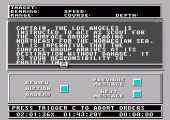

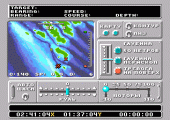
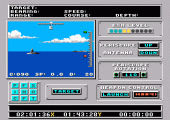
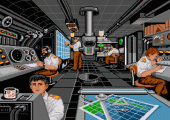
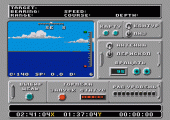
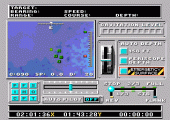
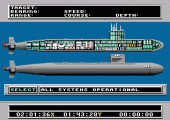
Solid in depth but quite boring on screen. CONCLUSION: 6/10